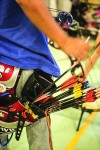Archery lovers in China
Putting down his cigarette, Beijing native Chen Ning arches his back to stretch and then nonchalantly exhales a tube of
smoke as he draws back the bowstring. Ping goes the release followed by a whoosh and then a thud in quick succession. It’s all one sound. He takes another arrow from the miniature golf-bag sized fanny pack drooped around his waist and takes aim: Ping-whoosh-thud… bull’s eye. That’s 10 points on the target. Chen, 33, revisits the cigarette once again, a look of satisfaction on his face.
“China is not taking care of archery at all. It’s really quite pathetic,” Chen fumes between drags. Chen is one of roughly 1,000 fee-paying members at Beijing’s Sunny Focus Sports Club in Sanyuanqiao, Chaoyang district. It’s one of the few places with comprehensive indoor archery facilities in the city center.
Chen says that despite the large number of archery lovers in China, the government is doing very little in terms of funding and promotion for the sport. He laments that archery still falls short of making broadcast schedules for terrestrial television. “It’s not exactly like football,” he notes glumly.
In some ways, it is surprising that Chinese archery has not become a hit with the public. The sport received a natural upsurge in popularity during the 2008 Beijing Olympic Games when Shandong native Zhang Juanjuan became the first non-Korean since 1984 to win gold in the women’s individual event. Last summer in London, archer Dai Xiaoxiang became the first Chinese male to win a medal in the men’s individual event.
But for those smitten with the primitive weapon, widespread media coverage once every four years is nowhere near enough. According to Chen, compared with other countries, archery in China has yet to receive sufficient media exposure to entice sponsorship money that could help recruit and nurture talent at club level. Apart from the national teams, the sport is still very much a self-funded amateur endeavor. Clubs like Sunny Focus are thriving on the passion of their members.
“We spend our own money to take part in our own competitions,” Chen says. “The entrance fees pay for the trophies awarded to the winners.”
Arrows of desire
Flanking the sides of the large warehouse that is the club’s interior are banks of modern bows. The ones standing erect look like anorexic electric Flying V guitars but on diet pills. At both ends, banks of hay-filled sacks climb two-thirds up the walls. Paper targets hang precariously on large wooden toothpicks.
Ping-whoosh-thud. Archers fire away at the targets. Ping-whoosh-thud. When everyone is finished there is a collective nod to check for safety. They walk up to the targets tallying up their scores and to retrieve their arrows.
“An arrow would go straight through your body if you got hit from that range,” jokes Wang Zongwei, 25, manager at Sunny Focus. According to Wang, the club was founded 3 years ago in 2010 and is the largest of its kind in Beijing. Most members, he says, never use the facilities but those who do (about 200 regulars) come in the evenings after work or on the weekends when the club is busiest.
“Archery is not such a popular sport here and not many people are interested in it,” Wang says. But he does feel that there are more and more people taking it up. This he says is due in part to the emergence of archery depicted in TV shows and film. Wang gives the example of American adventure series Arrow – whose main protagonist, a vigilante, uses a bow and arrow as his weapon of choice.
“It’s true. We get many young people coming to the club saying, ‘I’ve just seen the series. It must feel so cool to shoot an arrow. I want to learn,'” Wang says excitedly. Wang theorizes that shows like Arrow definitely inspire people to get in touch with the sport.
But protagonists who seem to be deft archers as well have peppered Hollywood productions in recent years. In 2012 Pixar released Brave – a computer-animated fantasy whose leading character Merida uses a longbow. That summer, comic book blockbuster The Avengers hit cinema screens with audiences getting an eyeful of bow and arrow action sequences courtesy of Hawkeye – one of the main characters.
With the impending release of the sequel The Hunger Games: Catching Fire opening in Chinese cinemas on November 22, it’s quite conceivable that interest in archery will spike again. The first installment grossed $650 million (4 billion yuan), running on 67 IMAX screens in China alone. No point for guessing the weapons used by protagonist Katniss Everdeen in this dystopian fantasy.
From beast to bull’s eye
For Wang, the appeal of archery in China stems from its long history with the bow and arrow. It was once admired as one of the six ancient arts during the Shang Dynasty (C.1600-1046BC), a requisite skill for all noble gentry.
Wang says that he thinks most Chinese have a deep connection to archery, whether they know it or not, because the bow and arrow has played such a major role in forming modern society.
“In ancient times, arrows were used for hunting,” he says.
“After that archery was used as a weapon of war. And now it’s an Olympic sport. It has always been there.”
Wang Yue, 20, is the head coach at Sunny Focus and is a former archer with the Beijing Archery Team. Wang Yue concurs with Wang Zongwei (no relation) that people’s awareness of the sport exponentially increased with Zhang Juanjuan’s golden win in 2008.
And even though Wang Yue is impressed with the high level of skill on display at the club, especially with some of the more experienced members, he says that the future of archery in China must start with the kids.
“To develop any sport you need to start with the younger generation,” Wang Yue says.
He gives the example of South Korea, where archery is a mandatory school activity. The Koreans have a lot to live up to – the country’s best archers have tallied 32 medals since 1972.
“The Koreans are good because they put a lot of emphasis on the sport,” Wang Yue says matter-of-factly.
The most common bow used at the club is the Olympic reflex bow – a bow whose tips curve outward away from the archer. The other is known as the compound bow – a modern looking contraption that doesn’t look anything like a bow but is heavier and thus steadier, improving accuracy.
Catching up
Liu Jing is the winner of the female compound bow category of a 2013 national indoor championship. But away from
glory, she remembers a more austere time in 2011 when she first took part in an international archery competition in Thailand. She was shocked at the superior level of her Thai opponents, but is quick to draw positives from the experience.
“Maybe in China we thought we were quite good but it was obvious to me that we still have a long way to go to catch up with our international counterparts,” Liu reflects.
Liu, like Chen, feels the country doesn’t do enough to prioritize archery as a major sport, despite its Olympic status.
“It’s not as high-end as equestrianism,” Liu says.
Chen interjects and gives the example of the Archery World Cup – held in Shanghai in August – as proof that state media is inclined to overlook the sport.
“We have to stream archery competitions from foreign websites if we want to watch them,” Chen says.
“The TV stations here would rather broadcast some terrible football games from the lower leagues than broadcast live archery.”
Chen laments this injustice as televisual daylight robbery. Leading archers from around the world took part in Shanghai.
“Perhaps TV stations think that because [archery] is not that popular, people won’t watch it so there is no point,” Chen says. “This is fatal to the sport.”
Sun Siyu contributed to this story
Source: bjd.com.cn



You must be logged in to post a comment.